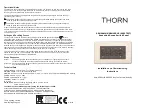
Attaching Switch Rails to the Switch and Mounting the
Chassis
You can mount the switch in 1U front-rack or 1U two-post (flush and center) configurations. Before you
mount the chassis, configure the rails and attach them to the switch. Refer to one of the following
procedures for the mounting configuration you are using:
Installing ReadyRails — Tool-less Method
Installing ReadyRails — Two-Post Flush-Mount Configuration
Installing ReadyRails — Two-Post Center-Mount Configuration
Installing ReadyRails — Four-Post Threaded Configuration
The following is an example of a 1U front-rack configuration.
NOTE: For the 1U two-post (flush and center) configurations, you can slide the switch into the rails
in the same manner as the four-post configurations.
1.
Attach the switch rails (inner chassis members) to the S4820T switch, as shown in item 1 in the
following figure. Item 2 in the figure shows the detail for the front standoff with the locking tab.
Figure 8. Attaching the Switch Rails
2.
After you have installed both switch rails, line them up on the previously mounted Ready-Rails and
slide the switch in until it is flush with the front of the rack. About three inches prior to full insertion,
the rail locking feature engages to keep the switch from inadvertently sliding out of the rack and
falling.
Attaching the Ground Cable
The S4820T requires one M4x0.7 screw to attach a ground cable to the chassis.
To properly ground the chassis, Dell Networking recommends a 6 AWG one-hole lug, #10 hole size, 63"
spacing. The one-hole lug must be a UL-recognized, crimp-type lug.
Install the Hardware
25
Summary of Contents for S4820T
Page 1: ...Installing the S4820T System April 2014 ...
Page 16: ...16 ...
Page 28: ...28 ...
Page 34: ...34 ...
Page 38: ...38 ...
Page 44: ...44 ...
Page 49: ... Dell Networking PVST MTU 12 000 bytes Technical Specifications 49 ...
Page 50: ...50 ...
Page 56: ...56 ...
















































